May, 1950
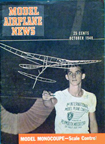
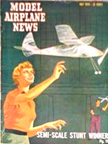 :
:
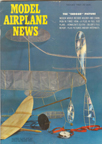
Model Airplane News Covers for October, 1948; May, 1950; and February, 1963
Indoor Models
Click to Enlarge
The October, 1948 cover features a man flying a microfilm-covered indoor rubber powered model at the 2nd International Model Plane Contest sponsored by Plymouth Motor Corp, Detroit, August 1948. The May, 1950 cover features a drawing (by Jo Kotula) of a lady flying a microfilm model.

Basics of Indoor Model Competition
he who flies thelongest wins...
Click to Enlarge
The February, 1963 cover was MAN's "Gala Indoor Issue". Here's what the blurb had to say:
"... Indoor modeler and photographer Sid Bernstein spent considerable time effort and money (26 cents) to compose this excellent cover photo. The props used cover all phases of indoor activity - Baby "Rise Off Ground" (ROG, "B" stick, hand launch glider, microfilm and tissue covered models, the inevitable stop watch and rubber winder..."
Of these the least familiar to the general public is "microfilm".
In 1930, "microfilm" model covering was invented by Robert Clary, a student at MIT. This thin transparent material came as a liquid which was poured on a surface of water. Volatile solvents evaporated, leaving a monomolecular layer. Techniques for removing it from the water with a metal frame and attaching it to a balsa model were developed by Emmanuel Feinberg and Jerome Kittel. The earliest use in competition was by Herbert Owen at the Eastern States Meet in NYC in December 1932.
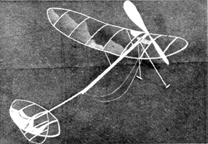
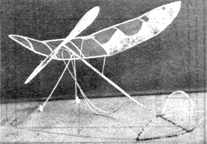
Indoor Duration Models Covered With Microfilm
Click to Enlarge
Why is this important? The principal event at an indoor competition is an endurance event -- the airplane that stays aloft the longest wins (within size classes). Regardless of size, weight is the determining factor in this contest. Before 1932, models were covered with tissue paper. The thinnest papers weigh about .011 oz./100 square inches. Microfilm weighs about a tenth of that. On a competitive model, the film could directly save 20% of the weight, and more because the lighter model requires less structure.
Microfilm quickly came to be de rigeur for serious Indoor models. These unusual, ultra-delicate floating skeletons are a fsacinating part of competition and resemble soap-bubbles as their ultra-thin covering refracts the light. In the year following Owen's flight, the record time increased from 14 minutes to 19. Today, it is over 30 minutes.
here is some video of contemporary indoor contest planes with microfilm covering.
Here are more photos from the Plymouth Contest
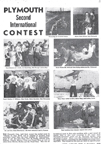
Photos from the Plymouth Contest
Click to Enlarge

Click to go back and select another cover.
Counter for the Entire Site (not just this page..)
Home | About Lindy | Last Week's Reviews | Upcoming Events | 1940s Collecibles
The Guide - Establishments - Travel - Accessories
Music | Links | Photo Gallery | Extras | Contact